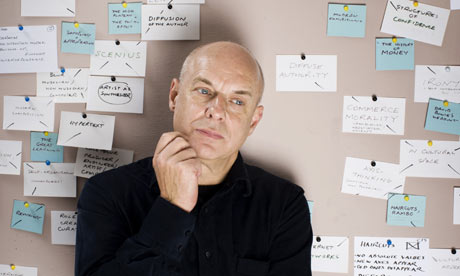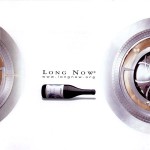Le Strategie Oblique sono state sviluppate nel ’74 da Brian Eno e Peter Schmidt.
Si tratta di un mazzo di carte su ognuna della quali è stampata una sentenza oracolare. Il loro scopo è quello di aiutare l’artista a prendere una decisione nel corso del delicato tragitto che conduce all’opera compiuta con una modalità di pensiero vicina a quella orientale (indubbiamente devono molto all’I Ching almeno come ispirazione). Così a volte ci si trova di fronte a istruzioni quasi operative (“Usa meno note”; “Lavora con un ritmo differente”), altre volte a consigli applicabili in molti modi (“Torna sui tuoi passi”; “Solo una parte, non il tutto”), qualche volta si sconfina nell’oracolo (“Non si tratta di costruire un muro, ma di fare un mattone”).
Sono state anche stampate in quattro edizioni, tutte leggermente differenti (le sentenze vanno e vengono): le prime tre (1975, 1978, 1979) regolarmente distribuite sul mercato (anche in ed. italiana da GammaLibri, 1983), la quarta, completamente diversa, per uso privato (1996).
Eno e Schmidt affermano:
Queste carte si sono sviluppate a partire dall’osservazione dei principi che regolano le nostre creazioni.
Talvolta [i suddetti principi] sono stati riconosciuti retrospettivamente (facendo così coincidere intelletto e intuizione), a volte sono stati identificati osservando ciò che è successo, altre volte si è trattato di formule.
Possono essere utilizzate come un tutto (una serie di possibilità costantemente riportate alla memoria) opure isolatamente, estraendo una carta dal mazzo mescolato quando si presenta un dilemma a un certo punto del lavoro. In questo caso, ci si rimette alla carta anche se l’applicazione non è chiara.
Le carte non danno responsi definitivi, nel senso che nuove idee si presenteranno spontaneamente mentre altre diventeranno via via evidenti.
[Eno, Schmidt, 1975, trad. mia]
La cosa interessante di questi oggetti è che, come l’I Ching e in fondo tutti i testi oracolari, possono portare a vedere le cose in un modo diverso dall’usuale. Invece di incaponirsi cercando una soluzione con i soliti mezzi, suggeriscono una via trasversale per uscire dall’impasse.
Esiste un sito dedicato alle strategie oblique che sono anche consultabili in linea.
The Oblique Strategies are a deck of cards. There are four versions. The first three editions (1975, ’78, ’79) were regularly on sale, the fourth (1996) is completely different, multilingual and printed for private use only.
They measured about 2-3/4″ x 3-3/4″. They came in a small black box which said “OBLIQUE STRATEGIES” on one of the top’s long sides and “BRIAN ENO/PETER SCHMIDT” on the other side. The cards were solid black on one side, and had the aphorisms printed in a 10-point sans serif face on the other.
The deck itself had its origins in the discovery by Brian Eno that both he and his friend Peter Schmidt (a British painter whose works grace the cover of “Evening Star” and whose watercolours decorated the back LP cover of Eno’s “Before and After Science” and also appeared as full-size prints in a small number of the original releases) tended to keep a set of basic working principles which guided them through the kinds of moments of pressure – either working through a heavy painting session or watching the clock tick while you’re running up a big buck studio bill. Both Schmidt and Eno realized that the pressures of time tended to steer them away from the ways of thinking they found most productive when the pressure was off. The Strategies were, then, a way to remind themselves of those habits of thinking – to jog the mind.
Eno ad Schmidt said:
These cards evolved from our separate observations on the principles underlying what we were doing. Sometimes they were recognized in retrospect (intellect catching up with intuition), sometimes they were identified as they were happening, sometimes they were formulated.
They can be used as a pack (a set of possibilities being continuously reviewed in the mind) or by drawing a single card from the shuffled pack when a dilemma occurs in a working situation. In this case,the card is trusted even if its appropriateness is quite unclear. They are not final, as new ideas will present themselves, and others will become self-evident.
This is the Oblique Strategies site. You can also consult the deck online.

 Paul Morley recently spoke to Brian Eno for a BBC arena documentary in which Eno proved that he is always good for a controversial and catchy phrase about the music industry:
Paul Morley recently spoke to Brian Eno for a BBC arena documentary in which Eno proved that he is always good for a controversial and catchy phrase about the music industry: Bloom, Trope and Air are three applications developed by Brian Eno and the musician / software designer Peter Chilvers that brings to the cells the concept of generative music popularized by Eno.
Bloom, Trope and Air are three applications developed by Brian Eno and the musician / software designer Peter Chilvers that brings to the cells the concept of generative music popularized by Eno.
 Ok, un po’ di tranquillità dopo lo sforzo organizzativo del Premio Nazionale delle Arti.
Ok, un po’ di tranquillità dopo lo sforzo organizzativo del Premio Nazionale delle Arti.
 Brian Eno’s
Brian Eno’s 